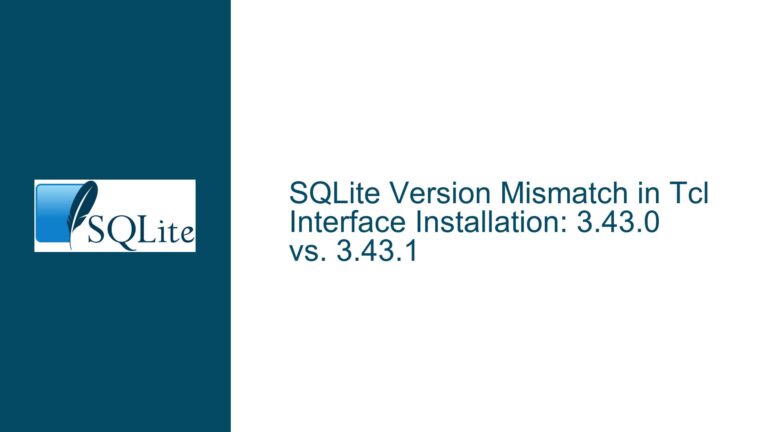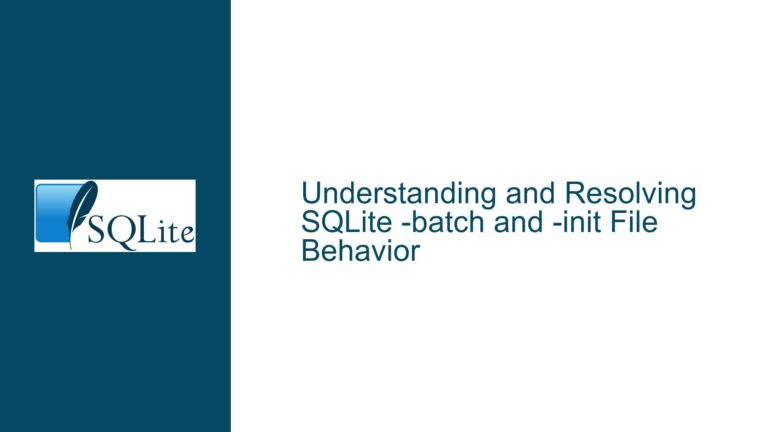the Role of Lone SELECT Statements in SQLite Triggers
The Purpose of Lone SELECT Statements in SQLite Triggers
SQLite triggers are powerful tools that allow developers to automate actions in response to specific database events, such as INSERT, UPDATE, or DELETE operations. One of the more nuanced aspects of SQLite triggers is the ability to include a standalone SELECT statement within the trigger body. At first glance, this might seem counterintuitive, as SELECT statements are typically used to retrieve data rather than perform actions. However, in the context of SQLite triggers, a lone SELECT statement serves specific purposes that are critical for enforcing business rules, validating data, and invoking custom functions.
The primary use case for a standalone SELECT statement in a trigger is to conditionally raise errors or abort operations using the RAISE function. For example, a SELECT statement can be used to check whether certain conditions are met and, if not, abort the operation with a custom error message. This is particularly useful for enforcing complex business rules that cannot be easily expressed through standard constraints like CHECK or NOT NULL. Additionally, a SELECT statement can be used to invoke application-defined functions that have side effects, such as logging changes or updating external systems.
Another important aspect of lone SELECT statements in triggers is their role in data validation. By embedding SELECT statements within a trigger, developers can perform intricate checks on the data being inserted, updated, or deleted. For instance, a SELECT statement can verify that a newly inserted record adheres to specific formatting rules, such as matching a regular expression pattern or conforming to a predefined structure. If the data fails these checks, the trigger can raise an error and prevent the operation from completing.
In summary, lone SELECT statements in SQLite triggers are not merely redundant or decorative; they serve as essential tools for enforcing business rules, validating data, and invoking custom functions. Understanding their purpose and proper usage is crucial for designing robust and maintainable database schemas.
Common Misconceptions and Pitfalls with Lone SELECT Statements
One of the most common misconceptions about lone SELECT statements in SQLite triggers is that they are unnecessary or redundant. This misconception often stems from a lack of understanding of the unique capabilities and limitations of SQLite triggers. Unlike some other database systems, SQLite does not support imperative programming constructs within triggers, such as loops or variable assignments. As a result, developers must rely on declarative SQL statements to achieve their goals, and lone SELECT statements are one of the few tools available for this purpose.
Another frequent pitfall is the misuse of NULL comparisons in SELECT statements within triggers. For example, a developer might write a condition like WHEN NEW.LOC_DTS_CREATED != NULL, which will never evaluate to true because NULL is not comparable using standard equality operators. Instead, the correct syntax is WHEN NEW.LOC_DTS_CREATED IS NOT NULL. This subtle but critical distinction can lead to unexpected behavior if overlooked, as the trigger may fail to enforce the intended business rules.
A related issue is the reliance on extensions or custom functions that may not be available in all environments. For instance, the REGEXP operator and custom functions like FS are not part of the core SQLite library and must be loaded as extensions. If a trigger depends on these extensions, it may fail to execute correctly in environments where they are not available. This underscores the importance of thoroughly testing triggers in all target environments and documenting any dependencies on extensions or custom functions.
Finally, some developers may attempt to use UPDATE...FROM statements within triggers, only to encounter syntax errors. This is because UPDATE...FROM is not supported in versions of SQLite prior to 3.33.0. If a trigger is designed to run on multiple versions of SQLite, it is essential to account for these differences in syntax and functionality. Failing to do so can result in triggers that work in some environments but fail in others, leading to inconsistent behavior and potential data integrity issues.
In conclusion, while lone SELECT statements in SQLite triggers are powerful tools, they must be used with care and attention to detail. Common pitfalls include misuse of NULL comparisons, reliance on unavailable extensions, and incompatibilities between SQLite versions. By understanding these potential issues and taking steps to avoid them, developers can create more robust and reliable triggers.
Best Practices for Using Lone SELECT Statements in SQLite Triggers
To effectively use lone SELECT statements in SQLite triggers, developers should adhere to a set of best practices that ensure clarity, reliability, and maintainability. These practices encompass proper syntax, thorough testing, and careful consideration of dependencies and compatibility.
First and foremost, it is essential to use the correct syntax for NULL comparisons. As mentioned earlier, conditions like WHEN NEW.LOC_DTS_CREATED != NULL will not work as intended. Instead, use WHEN NEW.LOC_DTS_CREATED IS NOT NULL to accurately check for NULL values. This simple but crucial adjustment can prevent subtle bugs and ensure that triggers enforce the intended business rules.
Another best practice is to thoroughly test triggers in all target environments. This includes testing for compatibility with different versions of SQLite, as well as verifying that any required extensions or custom functions are available and functioning correctly. For example, if a trigger relies on the REGEXP operator or a custom function like FS, it is important to confirm that these are properly loaded and operational in the target environment. Testing should also cover edge cases and invalid inputs to ensure that the trigger behaves as expected under all conditions.
Documentation is another critical aspect of using lone SELECT statements in triggers. Clearly document the purpose of each SELECT statement, the conditions it checks, and any dependencies on extensions or custom functions. This documentation should be included in the database schema or a separate design document, and it should be kept up to date as the schema evolves. Proper documentation not only aids in understanding and maintaining the triggers but also helps other developers who may need to work with the database in the future.
In addition to these general best practices, there are specific techniques that can enhance the effectiveness of lone SELECT statements in triggers. One such technique is the use of CASE expressions to handle multiple conditions within a single SELECT statement. For example, a CASE expression can be used to check various conditions and raise different error messages depending on which condition is met. This approach can simplify the trigger logic and make it easier to read and maintain.
Another technique is to modularize complex trigger logic by breaking it into smaller, more manageable pieces. For instance, instead of embedding a lengthy SELECT statement directly in the trigger, consider defining a view or a common table expression (CTE) that encapsulates the logic. This not only makes the trigger easier to understand but also allows the logic to be reused in other parts of the database.
Finally, it is important to consider the performance implications of lone SELECT statements in triggers. While these statements are generally efficient, they can introduce overhead if they involve complex queries or access large datasets. To mitigate this, optimize the queries used in SELECT statements by indexing relevant columns and avoiding unnecessary computations. Additionally, consider the frequency and context in which the trigger is executed, as this can impact overall database performance.
In conclusion, using lone SELECT statements in SQLite triggers requires careful attention to syntax, testing, documentation, and performance. By following best practices and employing techniques like CASE expressions and modularization, developers can create triggers that are robust, maintainable, and efficient. These practices not only enhance the functionality of the triggers but also contribute to the overall quality and reliability of the database schema.






